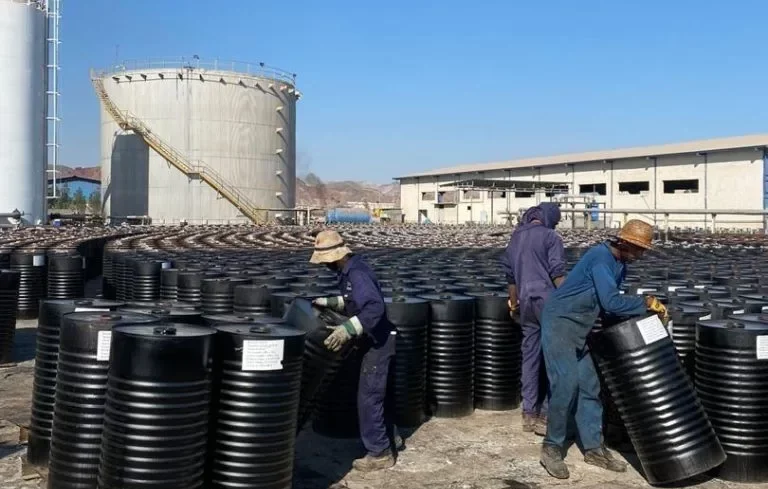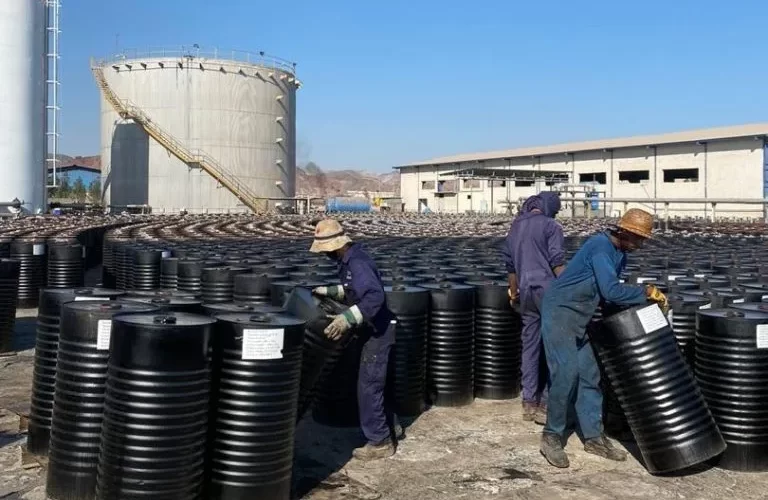 VG-40 Bitumen
VG-40 Bitumen
WHAT IS BITUMEN VG-40 ?
VG Bitumen 40, also known as viscosity grade 40 bitumen, is a type of bitumen that falls under the viscosity grading system used to classify bitumen based on its viscosity at a specific temperature. VG Bitumen 40 has specific properties that make it suitable for certain applications, particularly in road construction and asphalt paving.
HERE'S MORE INFORMATION ABOUT VG-40 BITUMEN:
Viscosity Grade Classification: VG Bitumen 40 is part of the viscosity grading system for bitumen. This system categorizes bitumen based on its viscosity at 60°C (140°F). VG 40 indicates that the bitumen has a specific range of viscosity at this temperature.
Viscosity Characteristics: VG 40 bitumen has a relatively higher viscosity compared to lower-grade bitumens like VG 10, VG 20, and VG 30. This means it is thicker and more resistant to flow at the specified temperature.
Usage in Road Construction: VG 40 bitumen is typically used in road construction for specific applications where a bitumen with higher viscosity is required. It is often used in the construction of roads and highways, particularly in regions with high traffic loads and hot climatic conditions.
Performance: The higher viscosity of VG 40 bitumen provides it with greater resistance to deformation (rutting) and cracking, especially in hot weather conditions. It helps maintain the stability and durability of the road surface.
Mixing and Application: VG 40 bitumen is mixed with aggregates at hot-mix asphalt (HMA) plants to produce asphalt concrete. The specific mix design and proportions may vary depending on the project’s requirements and traffic conditions.
Climate Considerations: VG 40 bitumen is particularly suitable for use in regions with high temperatures, where the road surface temperature can rise significantly. Its viscosity helps the asphalt mixture maintain its structural integrity under extreme heat.
Quality Control: Like other bitumen grades, quality control measures are essential when using VG 40 bitumen to ensure that the asphalt mix meets the specified standards and performance criteria.
Environmental Considerations: Sustainable asphalt technologies and recycling techniques can be employed when using VG 40 bitumen to reduce the environmental impact of road construction and maintenance.
In summary, VG 40 bitumen is a specific grade of bitumen with a higher viscosity, making it suitable for road construction in regions with heavy traffic and hot temperatures. It provides the necessary durability and performance characteristics required for these challenging conditions, and its use is guided by engineering standards and project specifications.
HISTORY OF BITUMEN VG-40
As of my last knowledge update in September 2021, VG40 bitumen is not a widely recognized or standardized viscosity grade within the conventional bitumen grading systems. Typically, the most commonly used viscosity grades for bitumen in road construction and asphalt paving are VG10, VG20, VG30, VG40, and so on, where the number represents the viscosity of bitumen at 60°C (140°F). However, it’s important to note that the specific grading systems and standards can vary by country and region. The history of bitumen grading systems, including viscosity grading, involves efforts to standardize bitumen to ensure consistent quality and performance in various construction applications.
HERE'S A GENERAL OVERVIEW OF THE HISTORY OF BITMEN GRADING:
Early Use of Bitumen: Bitumen has been used for thousands of years for various applications, including waterproofing, construction, and road building. In the past, bitumen was used in its natural state without standardized grading systems.
Development of Bitumen Testing: As road construction and infrastructure development became more common in the 19th and early 20th centuries, engineers and scientists recognized the need for consistent quality standards for bitumen. Various testing methods were developed to assess bitumen’s properties, including penetration testing and viscosity testing.
Penetration Grading System: The penetration grading system, based on penetration testing, was one of the earliest attempts to classify bitumen. It measured bitumen hardness. While penetration grading was widely used for many years, it had limitations in accurately predicting bitumen’s performance in different climates and conditions.
Viscosity Grading System: To address the limitations of the penetration grading system, the viscosity grading system was introduced. Viscosity grading measures the kinematic viscosity of bitumen at specific temperatures, usually at 60°C (140°F). VG40 bitumen, if it exists, would be classified based on its viscosity at 60°C within this viscosity grading system.
Development of Standards: Various organizations and standards bodies, such as ASTM (American Society for Testing and Materials) and AASHTO (American Association of State Highway and Transportation Officials), developed standards for bitumen grading, including the establishment of viscosity grade standards.
It’s important to check with local and regional authorities or standards organizations to determine the specific grading systems and standards in use in a particular area, as they can vary. As of my last update, VG40 bitumen may not be a widely recognized grade in some regions, and the availability of specific grades can change over time due to evolving industry practices and requirements.
PROPERTIES OF VISCOSITY GRADE BITUMEN 40
Viscosity: VG Bitumen 40 has a relatively high viscosity at 135°C (275°F). Viscosity measures a material’s resistance to flow, and higher viscosity bitumen is thicker and more viscous. This property is important for ensuring that the bitumen binds well with aggregates in hot mix asphalt (HMA) and maintains its structural integrity under heavy traffic loads.
Temperature Sensitivity: VG 40 bitumen’s viscosity decreases with increasing temperature, making it more workable at higher temperatures during the asphalt mixing and paving process. This temperature sensitivity is crucial for achieving proper compaction and adhesion of the asphalt mixture.
Adhesion: VG 40 exhibits good adhesion properties, allowing it to bond effectively with various aggregates, ensuring the durability and longevity of asphalt pavements.
Durability: Bitumen of this grade is known for its durability, which is essential for withstanding the stresses and strains imposed by heavy traffic loads and environmental factors.
Temperature Range: VG 40 bitumen can be used in a wide temperature range, from hot climates where it becomes a viscous liquid to cold climates where it solidifies. This versatility is important for its application in various geographic regions.
Elasticity: Bitumen has inherent elasticity, allowing it to deform and recover without cracking under the weight of traffic and temperature fluctuations. This property helps prevent the development of cracks and potholes in asphalt pavements.
Rheological Properties: VG 40 exhibits specific rheological properties, including complex viscosity and elastic modulus, which are crucial for designing asphalt mixtures that meet performance requirements.
Weather Resistance: VG 40 has good resistance to weathering, UV radiation, and water penetration, helping to maintain the structural integrity of the asphalt pavement over time.
Chemical Resistance: Bitumen is generally resistant to many chemicals, which is advantageous in road construction where it may come into contact with various substances.
Recyclability: Bitumen can be recycled, and reclaimed asphalt pavement (RAP) is often used in asphalt mixtures, reducing the demand for new bitumen and aggregates.
SAFETY OF VISCOSITY GRADE 40
Viscosity Grade 40 is a hazardous material and should be handled with care.
SOME SAFETY TIPS WHEN USING VG-40 ARE:
Protective Equipment: Always wear appropriate PPE when handling VG 40, including gloves, safety goggles, and protective clothing.
Ventilation: Ensure that there is adequate ventilation when using VG 40, as the fumes can be hazardous.
Handling and Transfer: Transport VG 40 in approved containers and vehicles, following all safety regulations.
PACKING OF BITUMEN VG-40
Bitumen VG 40 is typically packed and transported in a variety of ways.
Here are some common packing options for Bitumen VG 40:
- 180kg New Steel Drum: Loading 110 Drum in 20 ft
- 375Kg Bitubag: Loading 24 MT in 20 ft Container
- Bulk in vessel: Loading 2000 to 20,000 MT in Bitumen Carrier
- Bulk in Flexi Bag: Loading 20 MT in Bitumen Flexi Bag
- Bulk in Tanker: Loading 25 MT in Truck Tanker
TECHNICAL DATA SHEET OF BITUMEN VG40
Specification Unit Value Test Method
Absolute Viscosity, at 60 ◦C Poise Min 3200 ASTM D4402
Kinematic Viscosity, at 135 ◦C CST Min 400 ASTM D2170
Flash Point ◦C Min 220 ASTM D93
Solubility in Trichloroethylene %WT Min 99 ASTM D2042
Penetration Value, at 25 ◦C 0.1mm 40-60 ASTM D5
Softening Point ◦C Min 25 ASTM D36
Viscosity Ratio, at 60 ◦C ◦C Max 4 ASTM D4402
Ductility at 25 ◦C, after thin film oven test Cm Min 25 ASTM D113
For more information, please Contact our Sales Team.


